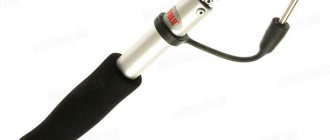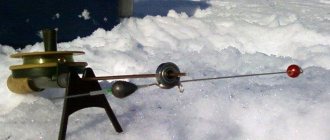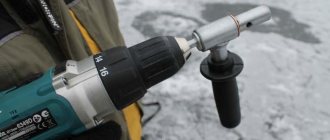Handmade device
The cheapest option would be a hand-made ice fishing pole. It consists of the following components:
- a wooden handle in the form of a strong handle, which has at its end a comfortable handle with a rope for a more durable fixation to the hand;
- The metal tip can be sharpened thick reinforcement, a crowbar tip, or an old file.
If the technical parameters are observed, such a product will not be inferior to the factory analogue, and due to some factors it may have a significant advantage. They can test the thickness of the ice or punch a hole of the required size.

The ice pick is most effective when the ice thickness is 7-15 cm.

Why it is not recommended to buy an ice pick in a store
We’ll talk about the advantages of the shapes of the pick tip a little lower, but now let’s focus on the handle. The matter of choosing a handle is not as simple as it seems at first glance.
What should the handle of the pick be like?
- When grasping the handle, the hand in the mitten should close completely.
- The thickness of the handle must ensure rigidity of holding, and therefore the handle should not be made of a constant diameter along the entire length, like a shovel.

In this case, when working, your hands get tired faster, being constantly in a tense state.
- Never sand the surface of the pick handle with fine sandpaper. Let it be rough and “ugly”, but a slight roughness makes it easier to hold.
- The height is selected according to the height of the fisherman. The minimum is shoulder level; in fact, when punching a hole, your back should be straight. In this case, the blows will be delivered more strongly and there will be less stress on the back. The total length of the pick will be small:
- Your back gets tired when punching holes.
- It becomes more difficult to use if you need to check the thickness of the ice when moving through dangerous places.
- In the case of “bathing” there is no possibility to use it as a pole.
- I can tell you from experience that the presence of a grip on the upper part of the handle makes it easier to use, because it serves as an additional stopper for the brush and somewhat balances the handle.
- A safety loop is required.
These are exactly the points that store-bought products often do not take into account.
Shapes of tips for pick-picks
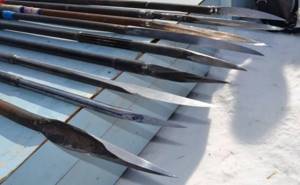
What shape of blade for an ice pick is the most effective will have to be decided directly while fishing in specific conditions, since the cutting part, its shape, is characterized by its use for specific work.
- Ice picks such as “chisel”, “pike”, “chisel” have a small mass and are good for thin and medium ice. They can be solid or collapsible. With their help, it is easy to break through the ice, measure its thickness and the depth of the reservoir, and even lower the bait. However, the hole developed with such picks has the shape of a cone, tapering downwards. Therefore, when the ice is thick, it is necessary to cut a fairly wide hole. In addition, ice bridges may form at the bottom of the hole, which are difficult to remove with such ice picks.
- The “saber” pick is usually made in one piece, with a wooden handle that has a massive thickening at the bottom. Due to its mass, shape and slight bending deformation, the “saber” is capable of breaking off large pieces of ice at the moment of impact. Physically strong fishermen make a hole with it very quickly, but it turns out with torn, sharp, uneven edges. This ice pick is convenient for frequent movements around a body of water and lure fishing.
- The “spatula” allows you to make a neat round or oval hole, but requires vigorous work and frequent freeing of the hole from ice crumbs. At the exit, the hole narrows a little, so in thick ice you have to cut a wider hole.
- The “petal” pick cuts a flat, almost non-tapering hole. Thanks to the pointed knife and the teeth on its cutting surface, the pick does not slide to the side or into the center of the hole when struck and even allows its lower part to be slightly expanded. If the blade is thin enough (6-8 millimeters), which is possible when it is made from high-quality steel, and if there is an additional reinforcing insert, the pick cuts deeply into the ice upon impact and breaks off fairly large pieces. In terms of operating efficiency, the “petal” is comparable to a “saber”, and in terms of the cleanliness of the side surface, it is comparable to a “spatula”.
A “petal” with upper and lower cutting edges is also capable of expanding the hole from below - chamfering its lower edge. This is often required when fishing for large fish on a thin line. In this design, the “petal” is shifted 10 millimeters to the side from the central axis and is mounted on a special stand. For the convenience of working with the ice pick in a “pull” motion, there is a pin in the upper part of the handle that prevents the hand from slipping and indicates the position of the upper cutting edge of the “petal” under the ice.
How to make an ice pick with your own hands and drawings for manufacturing - this will be a separate topic. For those who want to see what the famous Yakut ice pick is like, you are welcome to follow the link.
No tail, no scales. Regards, Oleg
Blueprints
Before starting production, you need to prepare a drawing of an ice pick for winter fishing. It is important to consider the following parameters:
- the height of the finished product must correspond to the level of the human shoulder joint;
- the pointed tip is approximately 30 cm long;
- The tip is attached to the handle using a special glass 10 cm high.

This principle produces a quality product. Depending on the shape of the tip, it has different purposes.
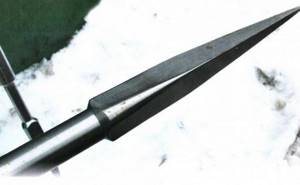
Ice pick to the first ice
I have long wanted to share a description of the ice pick. Now seems like the right time. The design is somewhat unusual, but I like it, maybe it will suit you too... The ice pick was made according to the sketch placed in the article (I am attaching a scanned and recognized file with the article, maybe it’s worth posting on the website, the original source is after all), as you can see, it’s not a very recent magazine , maybe someone missed it :). The magazine was carefully preserved by my father, because... Immediately from the moment I received it, I was inspired to make such an ice pick. Years passed, and then a few years ago (about 5-7) I got together and ended up making two - for me and for myself. He hasn’t planted his yet (he’s planning to :)), but I’ve been using mine for 5 years. The basic sensations are something like this. Unlike other ice picks, it makes almost no noise, because spicy. You don’t gouge thin (up to 10 cm) ice with it, but you pick at it, like how windshield wipers clean asphalt with a scraper, you scrape the ice at an angle of about 30 degrees (60 from the vertical). This is exactly how it should work, it turns out quietly and quickly. As soon as you pierce the ice, you immediately widen the hole like a knife, without removing it from the water and without splashing. By the way, picking on very thin ice allows you to avoid cracks. It easily penetrates ice as thick as your palm with a gentle vertical blow, without flying through or getting stuck, which is very useful when checking the thickness of the ice. For ice up to about 20 cm, you can use it instead of a spinner, the speed is almost the same. When placing the girders next to the main hole, you hit it vertically once, and quietly a couple more times, turning it around its axis - you get a neat hole for the girder stand. In general, I recommend it, an irreplaceable thing when you doubt the strength of ice. A friend made a similar one for himself, based on mine, and he also liked it. In general, the device looks cool, people on the pond pay attention and are amazed. Good luck! Appendix (Printed in the magazine “Hunting and Hunting Management”, 1965, No. 4, p. 38.) What kind of pick should a muskrat catcher use? V. PETROV, Postgraduate Student, Scientific Research Institute of Agriculture of the Far North Anyone who hunts muskrats in winter knows how labor-intensive it is to install a trap under the ice, the thickness of which in the second half of winter in the eastern and northern regions of the USSR often exceeds one meter. In these conditions, a good ice pick and the ability to wield it are of great importance. Unfortunately, muskrat catchers are not always able to select the sample of ice pick they need.
The author of this article tested 5 ice picks of four types, the main technical data of which are summarized in a table, and the appearance of their blades is shown in Figure 1. Tests showed that the structure of the ice and the weight of the pick have a significant impact on work performance. With a Yakut ice pick, in 9-12 minutes you can make a hole in ice a meter thick, and during the same time, with a chisel-shaped ice pick you can break through the ice to a depth of about 80-90 centimeters, with an awl-shaped heavy and groove-shaped one - to a depth of 65-70 centimeters, and with an awl-shaped light one - only by 60 centimeters. Thus, if 10 ice-holes are made with a Yakut ice pick, then during this time 8-9 ice-holes can be made with a chisel-shaped one, 6-7 with a heavy awl-shaped and groove-shaped one, and only 5-6 with a light awl-shaped one. From here it is easy to conclude that the use of Yakut ice picks reduces labor and time costs in making ice holes by 1.5-2 times. Yakut ice pick, as its name suggests, is used in Yakutia, where the climatic conditions are the most severe. In shape, it resembles a large knife with one-sided sharpening or a somewhat thickened Evenki “palm tree” (Fig. 2). Its size may vary. The figure shows the average dimensions: length about 50 centimeters, maximum blade width 5-6 centimeters, thickness at the butt 2-2.5 centimeters. The average weight of an ice pick with a shaft (black) is 3.5-4.0 kilograms. The thicker the ice, the heavier and thicker the ice pick should be. When fishing on small lakes, when the hunter is forced to make long treks on foot, the weight of the ice pick can be only 2.5-3 kilograms. The main requirement for an ice pick is the sharpness and straightness of the edge (Fig. 2). From the toe to the bell, this edge should be sharp and straight; together with the toe, it is the main working part. It is clear that edges 3 and 1 (blade) must also be sharp. To lighten the weight of the pick and give a sharp edge, the blade on the opposite side is made with a groove 4. The bell for attaching the pick to the shaft is made not in the form of a funnel, as usual, but in the shape of a dovetail groove with a gradual narrowing towards the tip of the pick. A shaft that fits tightly along the socket usually sits so firmly that it does not require additional fastening. For insurance purposes, a hole for a screw is still drilled on the wall of the socket. The shaft is made from birch. Its length is determined experimentally, depending on the habits of the muskrat catcher and the thickness of the ice. The thicker the ice, the longer the shaft should be. The thickness of the shaft is most often 5-6 centimeters without the usual thickening downwards, which is due to the peculiarity of the technique of using the pick. To prevent the ice pick from slipping out of your hands, a slight thickening is made at the upper end of the shaft; here a belt loop for the hand is inserted into a special hole. The technique of using the Yakut ice pick is somewhat unique and is as follows. Having made a small funnel-shaped depression in the ice, the muskrat catcher then chips away at the walls of the hole, gradually going deeper into the ice. In this case, the blade of the ice pick with edge 2 is turned outward, and the sharpened side is turned inside the ice hole. When sharpening an ice pick on the right side, the walls are sheared off in an ever-expanding spiral in a clockwise direction, and when sharpening on the left, it is done counterclockwise, i.e. butt forward. Working with the Yakut ice pick, even with little skill, is not very difficult.
| Pick type | Blade length in centimeters | Total length of the pick in centimeters | Total weight in kilograms |
| Trough-shaped lung | 59 | 142 | 2,0 |
| Awl-shaped heavy | 80 | 201 | 4,0 |
| Trench-shaped | 99 | 136 | 3,25 |
| Chisel-shaped | 75 | 178 | 3,25 |
| Yakutskaya | 48 | 198 | 3,75 |
Features of the finished product
Before you make an ice pick for winter fishing, you need to decide for what purpose it will be used.
- wedge-shaped - gives an advantage when making a hole that tapers at the bottom;
- a chisel-shaped point allows you to make holes with vertical walls;
- triangular peaks penetrate dry ice well in severe frosts;
- a tip in the form of a spatula or chisel allows you to break off large blocks of ice.
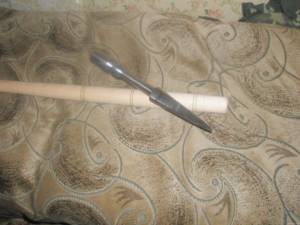
There are lightweight products weighing approximately 2.5 kg, used on ice 15 cm thick. Heavier items weighing up to 4.5 kg are available for thicker ice coverings.
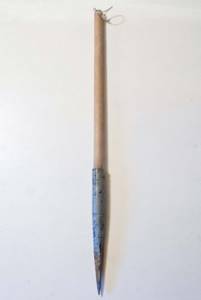
DIY ice pick for winter fishing
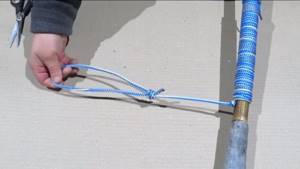
Hello everyone, winter is in full swing, you can meet a lot of fishermen on the ice. For winter fishing we need a tool such as an ice auger or an ice pick. The first option is more suitable for thick ice, since breaking through ice 15 centimeters thick is no longer so easy. As for the cases when fishing takes place on the first ice, melted ice or in places where the ice thickness is small, then such a thing as an ice pick is simply necessary. With it you can easily and quickly make holes in the ice, and it weighs less than a drill. You can also use an ice pick to fight off enemies, as well as “test” the ice for hardness. In this instruction we will look at how to make an ice pick with your own hands!
Materials and tools used by the author:
List of materials:
- steel pipe; - a strong wooden handle (shovel handle or similar); - old jeans; - epoxy adhesive; - self-tapping screws; - chisel; - strong synthetic rope.
List of tools:
- drill; - Bulgarian; - welding machine; - gas-burner; - caliper.
Picket making process:
Step one. Making a tip
Let's start with the most important thing - the tip. Here it is advisable to use strong metal if you want to break not only ice, but also something stronger. The author made the tip from a chisel; first, let’s find a piece of steel pipe of such a diameter that the chisel fits into it as tightly as possible. This will be a kind of adapter through which we will install the chisel into a pipe of larger diameter. In general, in this way you can ultimately obtain the required diameter of the pipe for the handle.
We weld all the parts together as tightly as possible. Finally, we sand everything so that the structure looks uniform. Here you can work with a grinder with a petal attachment.
Step two. We fasten the stalk
Let's secure the handle by inserting it into the pipe and drilling a hole for the self-tapping screw. It is better to use two self-tapping screws to secure everything tightly, otherwise the tip may fly under the ice.
After this, you can coat the tip with metal primer.
Step three. Pen
Let's make a good handle for the ice pick, since the ice pick will try to break out of the hand by inertia when cutting through the ice. And if the handle is still frozen and slippery, it will be very unpleasant to work with.
The author makes the handle from epoxy glue and fabric from jeans. We cut the rags and then wrap them with glue on the end of the handle. We carefully coat each new layer with glue. The handle should expand towards the end. Finally, we wrap everything with film and let the glue dry.
Step four. Finishing the handle
When the glue dries, we treat the handle with a petal attachment, as a result it will become rough and will hold well in the hand. Such a handle will also be quite warm, which is important in winter.
The author burns the cutting itself with a gas burner, and paints the tip with metal paint.
Step five. Rope
The ice pick must be equipped with a rope; without it, there is a high chance of losing the pick under the ice. The author installed the rope with a reserve, you never know what can happen while fishing. We drill a hole in the handle, thread the rope and wind it around the handle, and put on an elastic band to secure it. At the other end we make a tightening loop for the hand.
As a result, we got another warm handle by which the pick can be carried.
Become the author of the site, publish your own articles, descriptions of homemade products and pay for the text. Read more here.
Estimated cost
The factory price for an ice fishing pole can be very different. The following facts influence its cost:
- metal alloy used;
- special wood that meets the requirements for increased strength and performance parameters;
- quality of work when performing the product.
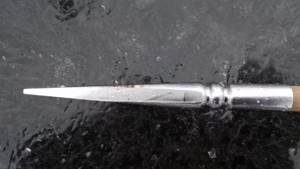
These are the main parameters that influence the pricing policy. It is clear that the brand of the company manufacturing them can be added to this.
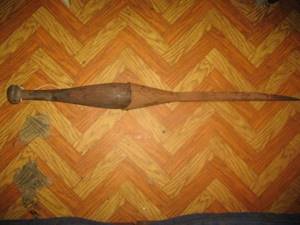
Making your own picket
Like other ammunition, an ice pick can be purchased at a specialized store. However, suitable options are not always available for sale. The easiest way is to make an ice pick for winter fishing with your own hands - it does not require large financial costs.
A wide variety of parts are used for manufacturing, which, at first glance, are not at all suitable for such a purpose: car springs, tractor cardans or a differential from an old Zaporozhets. Your imagination is limited only by the availability of components. Separately, it is worth noting the forged picks made to order.
Of course, you can take an ordinary metal crowbar with you when fishing, but using such a tool is inconvenient: you will quickly get tired and get frostbite on your hands. Since the fisherman will have to move a lot and hollow out several holes, this option is not suitable. So, what should you pay attention to when choosing materials for making an ice pick?
Handle
The best option is wood. Since the handle should be light and at the same time durable, birch, alder, beech or oak are suitable for this purpose. These rocks, among other things, dampen the vibrations that arise during the drilling of holes. To avoid getting your hands splintered, it is recommended to sharpen the surface and treat it with sandpaper. Alternatively, you can purchase a ready-made shovel cutting. There should be no difficulties when using such a tool.
Tip
This element can be impact or impact-cutting. Each application has its own characteristics. When making, consider what your pick will be used for. Possible options:
- Dovetail, that is, an ice pick with a forked end. It copes well with any task, but is difficult to manufacture.
- Chisel. With the help of such an ice pick you can break through thin ice on the surface or expand ready-made holes.
- Spatula. At the same time it cuts and crushes ice, forming round holes.
- Saber. The wide rod allows you to break off a large piece of ice, but using the tool requires a lot of physical strength.
- Pike. Cone-shaped nozzle, the easiest to manufacture. Penetrates into ice as much as possible, protecting against cracking.
- Tri- or tetrahedron. A variant of a pike that makes it easier to chisel ice thanks to its sharp edges.
Insurance
A through hole is drilled at the end of the handle into which the rope should be threaded. When chiseling ice, it is put on your hand and protects the tool from going under the ice. It would be nice if there was also a slight thickening at the end of the handle. There are no special requirements for insurance material . The main thing is that it is durable .
A budget option
The cheapest option is a homemade ice pick for winter fishing. In this case, a person receives a number of advantages:
- you can make a product to suit the characteristics of a specific person;
- the geometric configuration of the tip is selected in advance, capable of efficiently performing the assigned tasks;
- There is an opportunity to save significant money.
Thanks to this option, it is possible to safely move on the ice and punch holes of the required size.
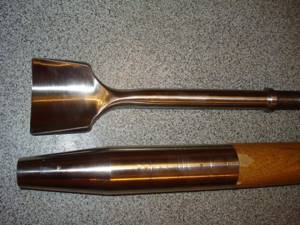
Best options
When deciding which is the best ice pick for winter fishing, you need to take into account the tasks for which it is intended.
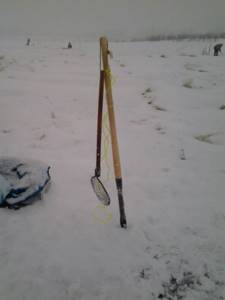
Avid fishermen have several product options at the same time:
- an ice pick weighing 2.5 kg is taken for walking on thin ice, in which case there is no need to wear a heavy analogue;
- a product weighing up to 4.5 kg is taken to work on thick ice;
- There are also different tips, because each of them is good for its own purposes.
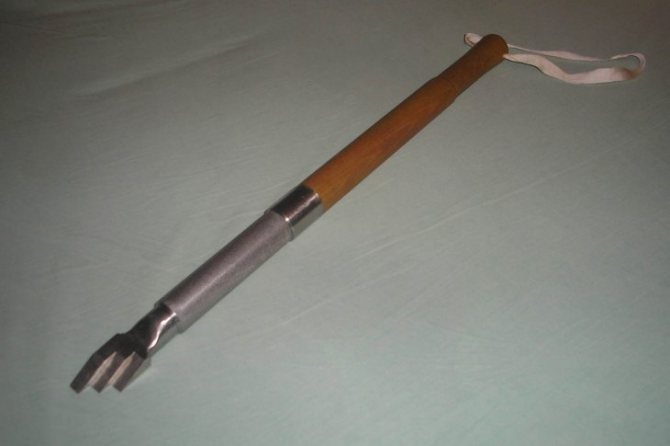
Thus, a person has a choice in his home arsenal, which greatly simplifies the solution of tasks.


